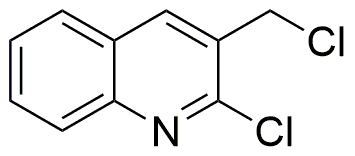2-Chloro-3-(chloromethyl)quinoline is widely utilized in research focused on:
- Pharmaceutical Development: This compound serves as a key intermediate in the synthesis of various pharmaceuticals, particularly in the development of anti-cancer agents.
- Material Science: It is used in the production of specialized polymers and coatings, enhancing properties such as chemical resistance and durability.
- Biological Research: Researchers employ this compound to study its effects on cellular processes, aiding in the understanding of disease mechanisms.
- Organic Synthesis: It acts as a versatile building block in organic chemistry, allowing chemists to create complex molecules efficiently.
- Pesticide Formulation: The compound is also explored in the formulation of agrochemicals, providing effective solutions for pest management.
General Information
Properties
Safety and Regulations
Applications
2-Chloro-3-(chloromethyl)quinoline is widely utilized in research focused on:
- Pharmaceutical Development: This compound serves as a key intermediate in the synthesis of various pharmaceuticals, particularly in the development of anti-cancer agents.
- Material Science: It is used in the production of specialized polymers and coatings, enhancing properties such as chemical resistance and durability.
- Biological Research: Researchers employ this compound to study its effects on cellular processes, aiding in the understanding of disease mechanisms.
- Organic Synthesis: It acts as a versatile building block in organic chemistry, allowing chemists to create complex molecules efficiently.
- Pesticide Formulation: The compound is also explored in the formulation of agrochemicals, providing effective solutions for pest management.
Documents
Safety Data Sheets (SDS)
The SDS provides comprehensive safety information on handling, storage, and disposal of the product.
Product Specification (PS)
The PS provides a comprehensive breakdown of the product’s properties, including chemical composition, physical state, purity, and storage requirements. It also details acceptable quality ranges and the product's intended applications.
Certificates of Analysis (COA)
Search for Certificates of Analysis (COA) by entering the products Lot Number. Lot and Batch Numbers can be found on a product’s label following the words ‘Lot’ or ‘Batch’.
Numéro de catalogue
Numéro de lot/série
Certificates Of Origin (COO)
This COO confirms the country where the product was manufactured, and also details the materials and components used in it and whether it is derived from natural, synthetic, or other specific sources. This certificate may be required for customs, trade, and regulatory compliance.
Numéro de catalogue
Numéro de lot/série
Safety Data Sheets (SDS)
The SDS provides comprehensive safety information on handling, storage, and disposal of the product.
DownloadProduct Specification (PS)
The PS provides a comprehensive breakdown of the product’s properties, including chemical composition, physical state, purity, and storage requirements. It also details acceptable quality ranges and the product's intended applications.
DownloadCertificates of Analysis (COA)
Search for Certificates of Analysis (COA) by entering the products Lot Number. Lot and Batch Numbers can be found on a product’s label following the words ‘Lot’ or ‘Batch’.
Numéro de catalogue
Numéro de lot/série
Certificates Of Origin (COO)
This COO confirms the country where the product was manufactured, and also details the materials and components used in it and whether it is derived from natural, synthetic, or other specific sources. This certificate may be required for customs, trade, and regulatory compliance.

